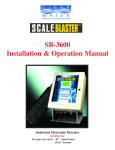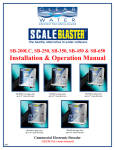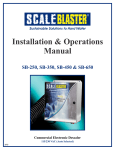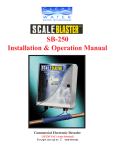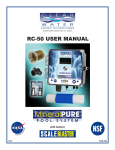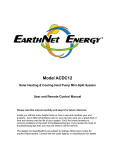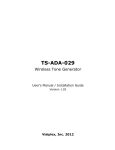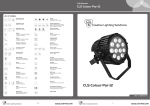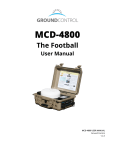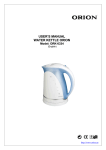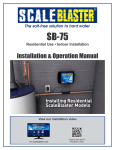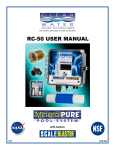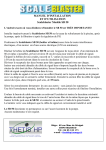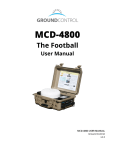Download SB-4000 User Manual
Transcript
The eco-friendly solution to hard water SB-1200, SB-2000, SB-2800, SB-3600 & SB-4000 Installation & Operation Manual Industrial Electronic Descaler 120/240 VAC (Auto Selected) 10/13 Table of Contents Section Description Page A) Identifying the ScaleBlaster Components................................................. 3 B) Installing the ScaleBlaster Control Box................................................... 4 C) Wrapping the Signal Wire......................................................................... 5-9 D) Powering up the Control Box................................................................... 10 E) LCD Indicator Screen............................................................................... 10 F) Error Screen and Codes............................................................................ 11 G) Calibrating the Signal Coil....................................................................... 12, 13 H) Adjusting the LCD Contrast..................................................................... 14 I) Changing the Frequency Sweep Mode..................................................... 14 Appendix 1) Model Number Dip Switch Settings......................................................... 15, 16 Appendix 2) Frequency Sweep Dip Switch Settings..................................................... 17 Appendix 3) Unit Specifications.................................................................................... 18, 19 Product Information Page 2 A.) Identifying the ScaleBlaster Components This ScaleBlaster unit includes the following components: 1) One ScaleBlaster control box. 2) One roll of 8 awg signal wire per number of channels. The total length of the cable will depend on the diameter and composition of the pipe to which it will attach. 3) Several long nylon cable ties, depending on number of channels. These ties aid in securing the cable to the pipe. 4) Warranty card (along with this Installation & Operations Manual) 5) Shipping Box. Please save the foam inserts and shipping box, it is made to protect the descaler during transport and is reusable in case the unit ever needs servicing at the factory. SB-1200, SB-2000, SB-2800, SB-3600 or SB-4000 3 2 1 5 4 Page 3 B.) Installing the ScaleBlaster Control Box Selecting the Installation Location and Mounting the ScaleBlaster Unit PLEASE READ THE ENTIRE MANUAL BEFORE BEGINNING INSTALLATION. THE LOCATION OF THE SIGNAL CABLE AND THE CONTROL BOX ARE CRITICAL WITH RESPECT TO PRODUCT PERFORMANCE. 1.) The unit should be installed by a licensed electrician, and the installation should meet all local and national codes. 2.) The best place to install the unit is on the main water line entering the facility, or on the line serving the relevant portion of the facility. First determine where the signal coils will be wrapped. This should be on a straight section of pipe (no elbows, tees, valves or couplings) that is at least four (4) feet long. Also, very important, the signal coils should be at least three (3) feet from any major source of electrical interference. The unit is splash-proof and can be installed outside if necessary. However, in this case a cover should be installed above the unit, and the unit should be kept out of direct sunlight. 3.) Mount the control box as close as possible to where the signal wire will wrap on the pipe, so that the cable is as short as possible. 4.) The control box, which has a 15-ft. power cord, should be mounted on a wall or other solid surface in a location near an electrical outlet or other power source. The unit is heavy and a sturdy installation is required. We recommend that you use a 3/8" lag and washer for each of the four mounting feet. (See photos below.) 5.) Upon being plugged in, the unit will work automatically on either 120 VAC or 240 VAC. NOTE: If you have any questions about installation, contact your dealer or Clearwater Enviro Technologies, Inc. for assistance. Photo 1 - recommended 3/8" mounting lag with washer. Photo 2 - one of the four control box mounting feet. Page 4 C.) Wrapping the Signal Wire Wrapping the Signal Wire Around the Pipe Included with the unit is one roll of 8 awg coil wire whose length is based on the size and composition of the pipe selected for installation. 1.) Carefully strip off 2" (51mm) of the outer rubber shield from the end of the signal wire. 2.) Insert one end of the coil wire into the coil wire inlet and attach to wire terminals (see below and also page 9). Turn liquid tight connectors to seal in wire. ON / OFF Switch inside enclosure Wire Terminals Coil wire inlets (liquid tight connectors) 3.) Route the signal wire from the control box to the inlet pipe. Hold the cable parallel and against the pipe and then secure the wire to the pipe with one of the nylon cables ties. Make sure that the tie is pulled tightly so that the wire is well-attached to the pipe. Remove excess cable tie with scissors. 4.) Using finger pressure to keep the signal wire and tie from moving, begin wrapping the signal wire securely around the pipe in any direction. The correct number of wraps depends on pipe size and composition. For proper product performance, it is imperative to wrap the correct number of times. To determine the number of wraps for ferrous pipe, consult pages 6-8. For non-ferrous pipe, please call Clearwater Enviro Technologies, Inc. to get this information. 5.) MAKE SURE THAT THE WRAPS ARE FLUSH AGAINST ONE ANOTHER–NEVER OVERLAPPING (see Photo 4a & 4b, page 9). NOTE: As previously indicated, make sure that the control box is mounted as close as possible to where the signal wire is wrapped on the pipe. 6.) Once the wrapping is complete, secure the signal wire to the pipe using another cable tie. Remove the excess cable tie with scissors. 7.) Route the loose end of the signal wire back to the control box. Trim the wire to length. Page 5 C.) Wrapping the Signal Wire (continued) Industrial Models SB-1200 PVC/PEX Pipe Size Pipe OD (in) Number of Wraps Type of Coil Wire Gauge (AWG) Length of Coil (in) Expected Wire Usage (ft)* Wire Pack Code 8" 8.625 39 Single 8 10.5 108.1 G 10" 10.750 30 Single 8 8.0 104.4 G 12" 12.750 24 Single 8 6.4 100.1 F Ferrous (Re-circulating) Pipe Size Pipe OD (in) Number of Wraps Type of Coil Wire Gauge (AWG) Length of Coil (in) Expected Wire Usage (ft)* Wire Pack Code 4" 4.500 61 Single 8 16.3 91.9 F 4 1/2" 5.000 57 Single 8 15.3 94.6 F 5" 5.563 54 Single 8 14.5 98.6 F 6" 6.625 51 Single 8 13.7 108.5 G Ferrous (One-Shot) Pipe Size Pipe OD (in) 2 1/2" 2.875 3" 3.500 Number of Wraps Type of Coil Wire Gauge (AWG) 30 Double 8 Length of Coil (in) Expected Wire Usage (ft)* 8.0 67.6 27 Double 8 7.2 71.7 * Expected Wire usage includes the wire used on the coil and both leads (10ft ea) connecting the unit to the coil. Wire Pack Code F F SB-2000 PVC/PEX Pipe Size Pipe OD (in) Number of Wraps Type of Coil Wire Gauge (AWG) Length of Coil (in) Expected Wire Usage (ft)* Wire Pack Code 18" 18.000 17 Single 8 4.6 100.1 F 20" 20.000 15 Single 8 4.0 98.5 F Ferrous (Re-circulating) Pipe Size Pipe OD (in) Number of Wraps Type of Coil Wire Gauge (AWG) Length of Coil (in) Expected Wire Usage (ft)* Wire Pack Code 12" 12.750 34 Single 8 9.1 133.5 G 14" 14.000 31 Single 8 8.3 133.6 G Ferrous (One-Shot) Pipe Size Pipe OD (in) Number of Wraps Type of Coil Wire Gauge (AWG) Length of Coil (in) Expected Wire Usage (ft)* Wire Pack Code 6" 6.625 51 Single 8 13.7 108.5 G 7" 7.625 49 Single 8 13.1 117.8 G 8" 8.625 46 Single 8 12.3 123.9 * Expected Wire usage includes the wire used on the coil and both leads (10ft ea) connecting the unit to the coil. Page 6 G C.) Wrapping the Signal Wire (continued) Industrial Models SB-2800 PVC/PEX Pipe Size Pipe OD (in) Number of Wraps Type of Coil Wire Gauge (AWG) Length of Coil (in) Expected Wire Usage (ft)* Wire Pack Code 20" 20.000 15 Single 8 4.0 98.5 24" 24.000 12 Single 8 3.2 95.4 F 30" 30.000 11 Single 8 2.9 106.4 G F Ferrous (Re-circulating) Pipe Size Pipe OD (in) Number of Wraps Type of Coil Wire Gauge (AWG) Length of Coil (in) Expected Wire Usage (ft)* Wire Pack Code 14" 14.000 31 Single 8 8.3 133.6 G 16" 16.000 24 Single 8 6.4 120.5 G 18" 18.000 22 Single 8 5.9 123.7 G 20" 20.000 21 Single 8 5.6 130.0 G Ferrous (One-Shot) Pipe Size Pipe OD (in) Number of Wraps Type of Coil Wire Gauge (AWG) Length of Coil (in) Expected Wire Usage (ft)* Wire Pack Code 8" 8.625 46 Single 8 12.3 123.9 G 9" 9.625 43 Single 8 11.5 128.3 G 10" 10.750 41 Single 8 11.0 135.4 * Expected Wire usage includes the wire used on the coil and both leads (10ft ea) connecting the unit to the coil. G SB-3600 PVC/PEX Pipe Size Pipe OD (in) Number of Wraps Type of Coil Wire Gauge (AWG) Length of Coil (in) Expected Wire Usage (ft)* Wire Pack Code 30" 30.000 11 Single 8 2.9 106.4 G 36" 36.000 9 Single 8 2.4 104.8 G Ferrous (Re-circulating) Pipe Size Pipe OD (in) Number of Wraps Type of Coil Wire Gauge (AWG) Length of Coil (in) Expected Wire Usage (ft)* Wire Pack Code 20" 20.000 21 Single 8 5.6 130.0 G 22" 22.000 19 Single 8 5.1 129.4 G 24" 24.000 17 Single 8 4.6 126.8 G Ferrous (One-Shot) Pipe Size Pipe OD (in) 10" 10.750 12" 12.750 Number of Wraps Type of Coil Wire Gauge (AWG) 41 Single 8 Length of Coil (in) 11.0 Expected Wire Usage (ft)* 135.4 34 Single 8 9.1 133.5 * Expected Wire usage includes the wire used on the coil and both leads (10ft ea) connecting the unit to the coil. Page 7 Wire Pack Code G G C.) Wrapping the Signal Wire (continued) Industrial Models SB-4000 PVC/PEX Pipe Size Pipe OD (in) Number of Wraps Type of Coil Wire Gauge (AWG) Length of Coil (in) Expected Wire Usage (ft)* Wire Pack Code 36" 36.000 9 Single 8 2.4 104.8 G 42" 42.000 7 Single 8 1.9 97.0 F Ferrous (Re-circulating) Pipe Size Pipe OD (in) Number of Wraps Type of Coil Wire Gauge (AWG) Length of Coil (in) Expected Wire Usage (ft)* Wire Pack Code 24" 24.000 17 Single 8 4.6 126.8 G 30" 30.000 13 Single 8 3.5 122.1 G Ferrous (One-Shot) Pipe Size Pipe OD (in) Number of Wraps Type of Coil Wire Gauge (AWG) Length of Coil (in) Expected Wire Usage (ft)* Wire Pack Code 12" 12.750 34 Single 8 9.1 133.5 G 14" 14.000 31 Single 8 8.3 133.6 G 16" 16.000 24 Single 8 6.4 120.5 * Expected Wire usage includes the wire used on the coil and both leads (10ft ea) connecting the unit to the coil. G - Important Notice If you are sizing a commercial and/or industrial model, we strongly recommend you contact the engineers at ScaleBlaster for the proper sizing and location of the installation. While the pipe size is a critical criteria for the sizing of a ScaleBlaster unit, other factors such as water hardness, the actual application, type of pipe, flow rates, direction and length of pipe can affect the proper decision on what model to use. Page 8 C.) Wrapping the Signal Wire (continued) Photo 4a & 4b - Examples of tightly wrapped signal wire Channel One Coil Wire Inlets: Connect first signal wire thru these coil wire inlets and attach the wire to the wire terminals inside. K-Flex Conduit Connector Photo 5 - bottom of unit Main Input Cable: 90-264 VAC, 47-63Hz D.) Powering up the Control Box / Computer Power Requirements and Considerations for the ScaleBlaster Control Box Please Note: YOU MUST FOLLOW ALL LOCAL, STATE, NATIONAL OR INTERNATIONAL CODES WHEN INSTALLING. A CERTIFIED ELECTRICIAN WILL BE REQUIRED. The control box auto switches between 115VAC and 230VAC, there is no need to make any internal adjustments. 1.) The control box must be connected to the power source by a wire conduit. The control box ships from the factory with a ½” K-Flex conduit connector on it. However, the installer can change the conduit connector to another style if needed. The new connector should also be a water tight conduit connector. The existing hole in the enclosure for the conduit connector is 7/8”. Again this installation should be done by a licensed electrician. Page 9 D.) Powering up the Control Box / Computer (continued) 2.) Wire the control box to the power source as shown in the diagram to the right. 3.) When ready to operate unit, turn the power switch to the on position. OFF ON E.) LCD Indicator Screen This ScaleBlaster unit has an LCD screen on the front of the control box that provides information on operation on the descalers operational condition. Start-up Screen Main Screen The start-up screen is displayed for approximately 10 seconds while the unit initializes. The main screen show most of the operation condition of the ScaleBlaster control box. Model Number Output Status Coil Voltage Internal Temperature Enclosure Temperature Firmware Revision Level Channel Number Frequency Sweep Range Total Hours of Operation Frequency Sweep Range Mode Number Descriptions of some of the screen indicators: Model Number: ScaleBlaster Industrial Models include the SB-1200, SB-2000, SB-2800, SB-3600, and SB-4000. Output Status: Output status of the coil current. The value of "100" indicates that the unit is functioning at 100%. Coil Voltage: This is the voltage applied to the induction coil (i.e., the coiled wraps on the pipe). These values should always be between 19.5 and 20.5 volts direct current. Internal Temp: This value indicates the internal temperature in degrees Fahrenheit. Enclosure Temp: Displays the temperature, in degrees Fahrenheit, of each channel's heatsink. Frequency Sweep Range: Frequency range the descalers output will sweep between. Mode Number: This number identifies a particular frequency sweep range, as set by the DIP switch. The unit is designed to permit selecting from among several pre-set sweep ranges via the DIP switch. (See "Additional Options: Frequency Sweep Mode", p. 17.) Page 10 F.) Error Screen and Codes This ScaleBlaster unit constantly scans for any malfunctions in the operation status of the unit. If an error is detected it is logged reported via the Unit Error Screen. This screen will display the channel and error that has occurred. A brief description of these errors are described below. Error List: Displays channel number and type of error that has occurred. List holds up to four errors. Error: In this example, the reading of "000" for the output status indicates a problem with the current at the coil for Channel 1. Sample Error Screen INTERNAL TEMP Error Displayed as: CH-1 INTERNAL TEMP The internal temperature sensor has recorded a temperature that is too high (above 150º F , 65.6º C) and has shut down that channel. One possible cause for this error is that the unit was installed in a location exposed to direct sunlight, which may make the unit overheat. Another possible reason for this is a failure of internal circuitry causing excess heat buildup. In this case, contact your dealer or ClearWater Enviro Technologies, Inc. ENCLOSURE TEMP Error Displayed as: CH-1 ENCLOSURE TEMP Enclosure and slave board heatsink temperature sensor has recorded a temperature that is too high (above 150º F , 65.6º C) and has shut down that channel. Possible cause for this error: internal circuitry failure. Contact your dealer or ClearWater Enviro Technologies, Inc. SMPS VOLTAGE Error Displayed as: CH-1 SMPS VOLTAGE The value shown at "Coil Voltage" is the main output in volts from the Switch Mode Power Supply located inside the control box. If this error occurs, check the output binding posts for that channel to make sure that they are not directly shorted together. If not, then there must be a failure of internal circuitry. Contact your dealer or ClearWater Enviro Technologies, Inc. COIL CURRENT Error Displayed as: CH-1 COIL CURRENT This indicates a failure in the main output current for that channel. Possible cause: the cable wire has been cut or disconnected from the output binding post. Page 11 G.) Calibrating the Signal Coil Calibrating the Industrial unit to match Coil / Pipe Variations The unit has been factory calibrated to the pipe similar to that of the actual installed pipe. However there may be differences in the pipe material, pipe wall thickness, and coil wrapping techniques witch may require the unit to be re-calibrated. The following will instruct the installer how to accomplish this task. Tools required, a large regular screw driver, and a small jewelers screw driver. Note that even though the instructions are using different models to show the calibration process, the process is virtually identical for each model. Step 1) Make sure unit is at room temperature, DO NOT calibrate unit while the unit is warm. Please wait till the unit has returned to room temperature. Then, open the door on the unit using the large regular screw driver. Control unit with door closed Control unit with door opened showing electronics inside Step 2) Use the small jewelers screwdriver to move the bottom four dip switches to the positions shown in the picture below. Note: DO NOT move any of the top four dip switches. Don't Care Don't Care Don't Care Don't Care OFF OFF OFF ON View of the master board showing location of the Dip Switch Close up view of the Dip Switch set for calibration mode Page 12 G.) Calibrating the Signal Coil (continued) Step 3) Locate the slave board, and the small blue potentiometer located at the upper right side of that board. View showing all boards Close up view of slave board Close up view of potentiometer on slave board Step 4) With the coil attached, power up unit and notice that it now comes up in calibration mode (M9). Step 5) Now the unit is in calibration mode, the output power reading is changed in this mode to display the under/over current error trip point. This reading should be between 40 and 60. If output power is lower then 040, then using the small jewelers screwdriver, turn the small screw on the blue potentiometer, (the blue square thing) clock wise, this will increase the output power reading. Likewise if the output power reading is more then say 060, adjust the potentiometer counter clockwise till it is between 40-60. Please note that the exact reading is not critical, and where from 40 to 60 will allow the unit to operate with in the normal operating parameters. View of the units screen in normal mode (M4). Note if the unit is not responding to the above calibration then, turn the potentiometer 20 full turns counter-clockwise. This will reset the unit to its default minimum value. Then repeat step 5. Note this will not increase the output power. This adjustment is for the internal microcontroller reference for sensing over and under current conditions. View of the units screen in calibration mode (M9). Don't Care Don't Care Don't Care Don't Care ON ON OFF OFF Step 6) Once the adjustment has been made, power down unit and reset the bottom four dip switches back to the normal operating mode, 1KHz to 20KHz (M4). View of the Dip Switch set for normal mode. Page 13 H.) Adjusting the LCD Contrast Depending of light conditions of the control boxes installation site, it might be necessary to adjust the LCD's contrast. To adjust the contrast of the LCD, first locate the Contrast Adjustment Control. Using a small, flathead screwdriver, rotate the control until the desired contrast is achieved. LCD Contrast Control Inside the unit showing the LCD screen Back side of the LCD screen showing the Contrast Control I.) Changing the Frequency Sweep Mode This unit has a patent-pending feature that allows you to adjust the frequency sweep range via the DIP switch (below). The range has been factory set, and we recommend that you do not change this without first consulting Clearwater's engineers. DIP Switch Main Control PC Board View of main Control PC Board Close-up view showing DIP Switch Page 14 Appendix 1) Model Number Dip Switch Settings This is factory set and should not be adjusted by the end user. These switches will not increase the power to the unit, that can only be done at the factory. These settings are only for reference in the case that they were altered by mistake. SB-1200 Mode OFF OFF OFF OFF Don't Care Don't Care Don't Care Don't Care SB-2000 Mode ON ON OFF OFF Don't Care Don't Care Don't Care Don't Care SB-1400 Mode SB-1800 Mode Discontinued Discontinued ON OFF OFF OFF Don't Care Don't Care Don't Care Don't Care SB-2800 Mode OFF OFF ON OFF Don't Care Don't Care Don't Care Don't Care SB-4000 Mode OFF ON ON OFF Don't Care Don't Care Don't Care Don't Care Page 15 OFF ON OFF OFF Don't Care Don't Care Don't Care Don't Care SB-3600 Mode ON OFF ON OFF Don't Care Don't Care Don't Care Don't Care Appendix 1) Model Number Dip Switch Settings (continued) This is factory set and should not be adjusted by the end user. These switches will not increase the power to the unit, that can only be done at the factory. These settings are only for reference in the case that they were altered by mistake. SB-2800 Single Mode ON ON ON OFF Don't Care Don't Care Don't Care Don't Care SB-5400 Single Mode OFF ON OFF ON Don't Care Don't Care Don't Care Don't Care SB-8400 Single Mode ON OFF ON ON Don't Care Don't Care Don't Care Don't Care SB-3600 Single Mode OFF OFF OFF ON Don't Care Don't Care Don't Care Don't Care SB-6400 Single Mode ON ON OFF ON Don't Care Don't Care Don't Care Don't Care SB-9400 Single Mode OFF ON ON ON Don't Care Don't Care Don't Care Don't Care Page 16 SB-4000 Single Mode ON OFF OFF ON Don't Care Don't Care Don't Care Don't Care SB-7400 Single Mode OFF OFF ON ON Don't Care Don't Care Don't Care Don't Care Future Use ON ON ON ON Don't Care Don't Care Don't Care Don't Care Appendix 2) Frequency Sweep DIP Switch Settings This is factory set and should not be adjusted by the end user. These switches will not increase the power to the unit, that can only be done at the factory. These settings are only for reference in the case that they were altered by mistake. Mode 1 - 1KHz to 5KHz Mode 2 - 1KHz to 10KHz Mode 3 - 1KHz to 15KHz Sets the frequency sweep range of the unit to sweep from 1,000 hertz to 5,000 hertz. Sets the frequency sweep range of the unit to sweep from 1,000 hertz to 10,000 hertz. Sets the frequency sweep range of the unit to sweep from 1,000 hertz to 15,000 hertz. Don't Care Don't Care Don't Care Don't Care OFF OFF OFF OFF Don't Care Don't Care Don't Care Don't Care ON OFF OFF OFF Don't Care Don't Care Don't Care Don't Care OFF ON OFF OFF Mode 4 - 1KHz to 20KHz Mode 5 - 1KHz to 2KHz Mode 1 - 2KHz to 4KHz Sets the frequency sweep range of the unit to sweep from 1,000 hertz to 20,000 hertz. Sets the frequency sweep range of the unit to sweep from 1,000 hertz to 2,000 hertz. Sets the frequency sweep range of the unit to sweep from 2,000 hertz to 4,000 hertz. Don't Care Don't Care Don't Care Don't Care ON ON OFF OFF Don't Care Don't Care Don't Care Don't Care OFF OFF ON OFF Don't Care Don't Care Don't Care Don't Care ON OFF ON OFF Mode 7 - Cal. Auto Tune Mode 8 - Use Auto Tune Mode 9 - Calibrate Coil Future Use Future Use Used to calibrate the signal coil to the ScaleBlaster unit. Don't Care Don't Care Don't Care Don't Care OFF ON ON OFF Don't Care Don't Care Don't Care Don't Care ON ON ON OFF Page 17 Don't Care Don't Care Don't Care Don't Care OFF OFF OFF ON Appendix 3) Specifications Industrial Descalers Specification Sheet for: SB-1200, SB-2000, SB-2800, SB-3600 and SB-4000 Input Wattage: SB-1200 - 275 Watts, SB-2000 - 300 Watts, SB-2800 - 600 Watts, SB-3600 - 900 Watts, SB-4000 - 1200 Watts Input Current: 2A rush @ 115 VAC, 1A rush @ 230 VAC Number of Output Channels: SB-1200: One SB-2000: One SB-2800: Two SB-3600: Three SB-4000: Four Output Voltage: 20 VDC (All units except SB-1200) Output Voltage: 12 VDC (SB-1200 only) Output Current: 10 Amps Peak Min. @1KHz* (All units except SB-1200) per channel * Maximum coil inductance: 200uH. Output Current: 6 Amps Peak Min. @1KHz* (SB-1200 only) * Maximum coil inductance: 200uH. Type of Descaler: Alternating Magnetic Field Transducer type: Solenoid Coil, using copper wire Output Signal: AC Square wave, Frequency user selectable: Factory set to: 1KHz to 20KHz Available Frequencies: 1KHz to 5KHz, 1KHz to 10KHz, 1KHz to 15KHz, 1KHz to 2KHz, 2KHz to 4KHz Circuit Protection: • Thermal overload protection on Switch-Mode Power Supply (SMPS) • Over voltage protection on SMPS • Over current protection on SMPS • Micro-controller monitoring of enclosure/heatsink over temperature shutdown • Micro-controller monitoring of internal over temperature shutdown • Output sensing circuit for over current immediate shutdown protection • Main input noise filtering Page 18 Appendix 3) Specifications Operational Status Indicators: Internal – using LCD display for full status on all channels External – using two LED lamps for a go / no go status. Green for Functioning, and Red for Not Functioning Enclosure: Wall mount, grey powder-coated, 16-gauge steel. Nema 4 and 12 rated. Operating Temperature: 10º F to 130º F (12º C to 54º C) Storage Temperature: 2º F to 150º F (17º C to 66º C) Physical Properties: SB-1200 Unit Dimensions: 16"x12"x6" SB-1200 Unit Weight: 17 LBS SB-1200 Shipping Crate Dimensions: 21”x17”x12” SB-1200 Shipping Weight: 33 LBS, Includes 1 set of Coil Wire and Packaging SB-2000 Unit Dimensions: 20”x16”x8” SB-2000 Unit Weight: 30 LBS SB-2000 Shipping Crate Dimensions: 26”x21”x14.5” SB-2000 Shipping Weight:46 LBS, Includes 1 set of Coil Wire and Packaging SB-2800 Unit Dimensions: 24”x20”x8” SB-2800 Unit Weight: 49 LBS SB-2800 Shipping Crate Dimensions: 36”x24”x15” SB-2800 Shipping Weight: 77 LBS, Includes 2 sets of Coil Wire and Packaging SB-3600 Unit Dimensions: 24”x20”x8” SB-3600 Unit Weight: 54 LBS SB-3600 Shipping Crate Dimensions: 36”x24”x15” SB-3600 Shipping Weight: 93 LBS, Includes 3 sets of Coil Wire and Packaging SB-4000 Unit Dimensions: 30”x24”x8” SB-4000 Unit Weight: 84 LBS SB-4000 Shipping Crate Dimensions: 38”x32”x16” SB-4000 Shipping Weight: 136 LBS, Includes 4 sets of Coil Wire and Packaging Page 19 The eco-friendly solution to hard water Manufactured by 8767 115th Ave. N. • Largo, FL 33773 Phone: 800-756-7946 or 727-562-5186 • Fax: 727-562-5187 clearwater-enviro.com MADE IN THE U.S.A.




















